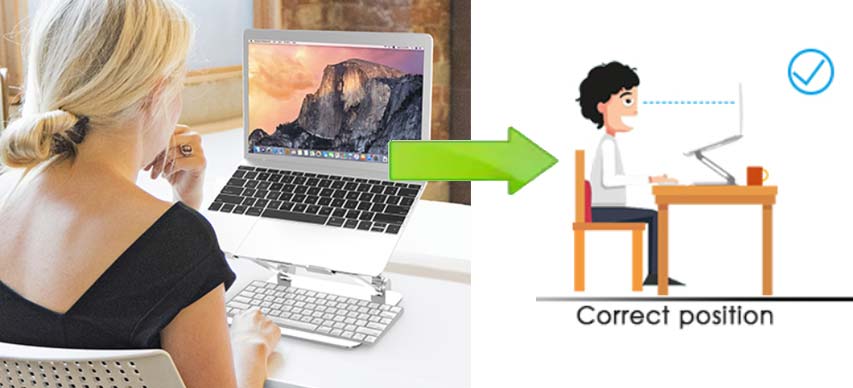Ergonomic Laptop Setup to Minimize Stress and Pain

Most people today are adept at using a computer, and many use laptops at home and work. But while using a laptop is very common, many people do not know how to set it up to increase their productivity and prevent some health issues related to improper use.
A laptop is very portable, so it is a favorite tool of many people, especially those who are always on the move. Many use it as their primary computer, but this practice is not advisable because laptops are not ergonomic. As a single unit with the monitor or screen and the keyboard attached, it isn’t easy to position it to the user’s best advantage.
So, whether you use a laptop for work, communication, or entertainment, you can use these ideas to ensure that your laptop is properly set up, so it is more comfortable and easier to use.
Ergonomic laptop setup
You may not notice it if you are using your laptop every day. The reality is, you can have bad posture when you continue to use your laptop without knowing how it set it up correctly. It is usual for the user to place the laptop flat on the desk, with the screen at a slight angle. The user’s usual tendency is to hunch over the desk while typing. You’ll soon experience pain on your neck, shoulders, arms, and lower back in this position.
1. Consider using a full-sized monitor and docking station
For portability and usability, the typical size of the laptop screen is between 12.5 to 14 inches. Laptops with larger screens are heavier and more suited for users who do not travel often.
To make a more ergonomic laptop setup more ergonomic, especially if you are working from home, consider investing in a full-sized monitor and docking station. The ideal size for an external monitor is 22 or 23 inches. Choose one that plugs into your laptop. You’ll have a clearer and larger display, and you can adjust the height of the monitor. Another option is to buy a docking station with a keyboard and mouse. You can connect your laptop to the docking station, allowing you to adjust the monitor’s position, mouse, and keyboard to the recommended height.

2. Invest in an external keyboard
Using the laptop’s trackpad is all right when you’re just typing. But it can be a challenge when you have to manipulate elements. Using an external keyboard is advisable so that you can adjust the laptop screen’s height. An external keyboard allows you to position your fingers properly over the keyboard and keep your elbows bent at a 90-degree angle. This is the correct position, which will prevent you from hunching over and building tension around your shoulders.
When using a computer table with a slide-out tray for the external keyboard, let the keyboard lay flat on the tray’s surface.
However, if the keyboard is on top of your table or desk, use the keyboard’s built-in risers and raise it at the minimum angle to help you type better.
3. Use an external mouse
While it is better to use an ergonomic external computer mouse, it is all right to use a regular mouse. An external mouse keeps your shoulders in a relaxed and open position, relieving pressure and reducing strain on your shoulders, arms, wrists, and fingers. Ideally, you should have a mouse pad with the right kind of padded support for your wrist. The support allows you mouse-using hand to remain neutral to avoid nerve compression on your wrist due to repeated resting on the table.
4. Use a laptop riser/desk
Although the laptop is named as such because it can be placed on your lap, it is not advisable to put it on your lap while using it. Instead of placing the laptop on top of your desk, buy a laptop rise or portable desk explicitly made for laptops. With it, you can raise the screen into the proper height. The recommendation is for the top edge of the screen to be at your eye level.
Keep your feet flat on the floor or use a block or step to keep your feet flat together if you need to raise your ergonomic chair. Moreover, see to it that you support your back on your chair’s backrest.